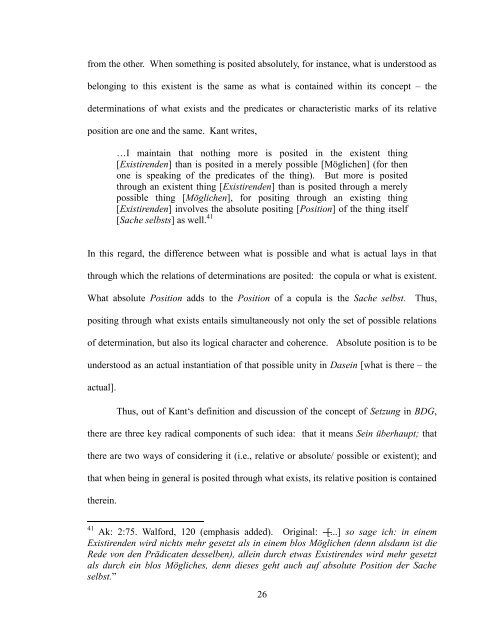The Doctrine of Self-positing and Receptivity in Kant's Late ...
The Doctrine of Self-positing and Receptivity in Kant's Late ...
The Doctrine of Self-positing and Receptivity in Kant's Late ...
You also want an ePaper? Increase the reach of your titles
YUMPU automatically turns print PDFs into web optimized ePapers that Google loves.
from the other. When someth<strong>in</strong>g is posited absolutely, for <strong>in</strong>stance, what is understood as<br />
belong<strong>in</strong>g to this existent is the same as what is conta<strong>in</strong>ed with<strong>in</strong> its concept – the<br />
determ<strong>in</strong>ations <strong>of</strong> what exists <strong>and</strong> the predicates or characteristic marks <strong>of</strong> its relative<br />
position are one <strong>and</strong> the same. Kant writes,<br />
…I ma<strong>in</strong>ta<strong>in</strong> that noth<strong>in</strong>g more is posited <strong>in</strong> the existent th<strong>in</strong>g<br />
[Existirenden] than is posited <strong>in</strong> a merely possible [Möglichen] (for then<br />
one is speak<strong>in</strong>g <strong>of</strong> the predicates <strong>of</strong> the th<strong>in</strong>g). But more is posited<br />
through an existent th<strong>in</strong>g [Existirenden] than is posited through a merely<br />
possible th<strong>in</strong>g [Möglichen], for <strong>posit<strong>in</strong>g</strong> through an exist<strong>in</strong>g th<strong>in</strong>g<br />
[Existirenden] <strong>in</strong>volves the absolute <strong>posit<strong>in</strong>g</strong> [Position] <strong>of</strong> the th<strong>in</strong>g itself<br />
[Sache selbsts] as well. 41<br />
In this regard, the difference between what is possible <strong>and</strong> what is actual lays <strong>in</strong> that<br />
through which the relations <strong>of</strong> determ<strong>in</strong>ations are posited: the copula or what is existent.<br />
What absolute Position adds to the Position <strong>of</strong> a copula is the Sache selbst. Thus,<br />
<strong>posit<strong>in</strong>g</strong> through what exists entails simultaneously not only the set <strong>of</strong> possible relations<br />
<strong>of</strong> determ<strong>in</strong>ation, but also its logical character <strong>and</strong> coherence. Absolute position is to be<br />
understood as an actual <strong>in</strong>stantiation <strong>of</strong> that possible unity <strong>in</strong> Dase<strong>in</strong> [what is there – the<br />
actual].<br />
Thus, out <strong>of</strong> Kant‘s def<strong>in</strong>ition <strong>and</strong> discussion <strong>of</strong> the concept <strong>of</strong> Setzung <strong>in</strong> BDG,<br />
there are three key radical components <strong>of</strong> such idea: that it means Se<strong>in</strong> überhaupt; that<br />
there are two ways <strong>of</strong> consider<strong>in</strong>g it (i.e., relative or absolute/ possible or existent); <strong>and</strong><br />
that when be<strong>in</strong>g <strong>in</strong> general is posited through what exists, its relative position is conta<strong>in</strong>ed<br />
there<strong>in</strong>.<br />
41 Ak: 2:75. Walford, 120 (emphasis added). Orig<strong>in</strong>al: ―[...] so sage ich: <strong>in</strong> e<strong>in</strong>em<br />
Existirenden wird nichts mehr gesetzt als <strong>in</strong> e<strong>in</strong>em blos Möglichen (denn alsdann ist die<br />
Rede von den Prädicaten desselben), alle<strong>in</strong> durch etwas Existirendes wird mehr gesetzt<br />
als durch e<strong>in</strong> blos Mögliches, denn dieses geht auch auf absolute Position der Sache<br />
selbst.‖<br />
26


